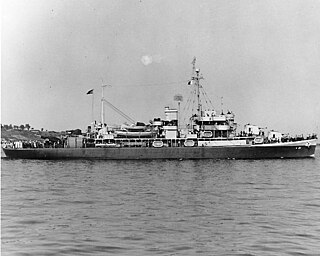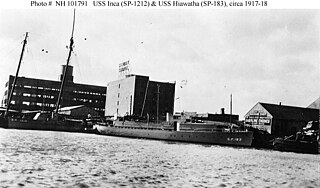
USS Goff (DD-247) was a United States Navy Clemson-class destroyer in commission from 1921 to 1931 and from 1932 to 1945. She saw service during the Second Nicaraguan Campaign and World War II. She was named for Secretary of the Navy Nathan Goff, Jr.

USS Duxbury Bay (AVP-38) was a United States Navy Barnegat-class small seaplane tender in commission from 1944 to 1966.
USLHT Amaranth was a schooner-rigged, twin-screw, wooden-hulled lighthouse tender of United States Lighthouse Service, which served as a vessel of the United States Navy during World War I, and as part of the United States Coast Guard during World War II.

USS Edithena was a United States Navy patrol vessel in commission from 1917 to 1919 that saw service during World War I. Prior to her U.S. Navy service, she operated as the private motor yacht Edithena from 1914 to 1917. After the conclusion World War I, she served as the fishery patrol vessel USFS Widgeon in the fleet of the United States Bureau of Fisheries from 1919 to 1940 and as US FWS Widgeon in the fleet of the Fish and Wildlife Service from 1940 to 1942. During World War II, she returned to U.S. Navy service from 1942 to 1944 as the yard patrol boat USS YP-200. By 1947 she had returned to private ownership, first as Edithena and during the 1970s and 1980s as the fishing vessel Ila Mae.

USS Gannet (AM-41) was an Lapwing-class minesweeper built for the United States Navy near the end of World War I.

USS Fern was originally a lighthouse tender built in 1871 by Delameter and Stack of New York City. She was transferred to the United States Navy from the United States Treasury Department on 30 January 1891. Fitted out as a gunboat, Fern was commissioned on 22 April 1891, with Lieutenant Commander A. J. Iverson in command.

The second USS Suwannee and third USS Mayflower was a United States Lighthouse Board, and later United States Lighthouse Service, lighthouse tender transferred to the United States Navy in 1898 for service as an auxiliary cruiser during the Spanish–American War and from 1917 to 1919 for service as a patrol vessel during World War I. She also served the Lighthouse Board and in the Lighthouse Service as USLHT Mayflower from 1897 to 1898, from 1898 to 1917, and from 1919 to 1939, and in the United States Coast Guard as the first USCGC Mayflower (WAGL-236) in 1939 and from 1940 to 1943 and as USCGC Hydrangea (WAGL-236) from 1943 to 1945.
USLHT Azalea was an American lighthouse tender that operated in the fleet of the United States Lighthouse Board from 1891 to 1910 and of the United States Lighthouse Service from 1910 to 1917 and from 1919 to 1933. During and in the immediate aftermath of World War I, she served in the United States Navy as USS Azalea from 1917 to 1919. During World War II, she became the U.S. Navy seaplane tender USS Christiana (YAG-32) in 1942.

USS Humboldt (AVP-21) was a United States Navy Barnegat-class small seaplane tender in commission from 1941 to 1947 that served in the Atlantic during World War II. She was briefly reclassified as a miscellaneous auxiliary and redesignated AG-121 during 1945. After the war, she was in commission in the United States Coast Guard as the cutter USCGC Humboldt (WAVP-372), later WHEC-372, from 1949 to 1969,
The second USS Mistletoe was a wooden lighthouse tender built in 1872 by Robinson Hoffman and Company in Chester, Pennsylvania.

The second USS Uncas was a United States Navy tug in commission from 1898 to 1922.

USS Maple, was a lighthouse tender that served in the United States Navy from 1893 to 1899, seeing service as an auxiliary ship during the Spanish–American War in 1898, and from 1917 to 1919, operating as a patrol vessel during World War I. She also served as USLHT Maple in the United States Lighthouse Board fleet from 1899 to 1910 and in the United States Lighthouse Service from 1910 to 1933.

The first USS Hiawatha (SP-183) was an armed yacht that served in the United States Navy as a patrol vessel from 1917 to 1920.
USS Fli-Hawk (SP-550) was a United States Navy patrol vessel in commission from 1917 to 1919.

USS Dreadnaught (ID-1951), later YT-534 and YNG-21, was a United States Navy tug that was in service from 1918 to 1944.

USS Raeo (SP-588) was a United States Navy patrol vessel in commission from 1917 to 1919. Prior to her U.S. Navy service, she operated as the motor passenger vessel Raeo from 1908 to 1917. After the conclusion of her U.S. Navy career, she served as the fishery patrol vessel USFS Kittiwake in the United States Bureau of Fisheries fleet from 1919 to 1940 and as US FWS Kittiwake in the Fish and Wildlife Service fleet from 1940 to 1942 and from 1944 to at least 1945, and perhaps as late as 1948. During World War II, she again served in the U.S. Navy, this time as the yard patrol boat USS YP-199. She was the civilian fishing vessel Raeo from 1948 to 1957, then operated in various roles as Harbor Queen from 1957 to 1997. She became Entiat Princess in 1998 and as of 2009 was still in service.

The second USS Calypso (SP-632) was a United States Navy patrol vessel in commission from 1917 to 1919. She originally operated as the private motorboat Calypso from 1909 to 1917. After the conclusion of her U.S. Navy career, she served as the fishery patrol vessel in the United States Bureau of Fisheries fleet from 1919 to 1940 as USFS Merganser and in the Fish and Wildlife Service fleet as US FWS Merganser from 1940 to 1942.

USS Katie (SP-660) is a civilian motor vessel which was commissioned into the United States Navy as a patrol vessel from 1917 to 1918.

USLHT Camellia was a lighthouse tender in commission in the fleet of the United States Lighthouse Service from 1911 to 1917 and from 1919 to 1939, and – as USCGC Camellia (WAGL-206) – in the fleet of the United States Coast Guard from 1939 to 1947. During World War I she briefly saw war service with the United States Army in 1917 before serving as the United States Navy patrol vessel USS Camellia from 1917 to 1919. She also saw service in World War II under U.S. Navy control while in the Coast Guard fleet. After the conclusion of her United States Government career, she operated for decades in the service of the Dominican Navy as Capotillo.

USLHT Zizania was a steel-hulled steamship built as a lighthouse tender in 1888. Over four decades of government service she sailed for the U.S. Lighthouse Service, and the U.S. Navy. She was homeported first in Wilmington, Delaware, and then in Portland, Maine during her Lighthouse Service Years. She served the U.S. Navy in both World War I and World War II. She was renamed during her World War II service, becoming USS Adario, a net tender based at Naval Operating Base Norfolk.















